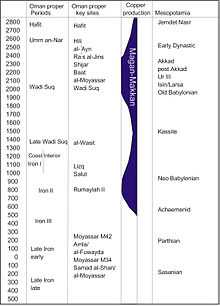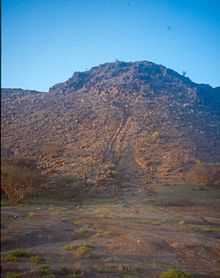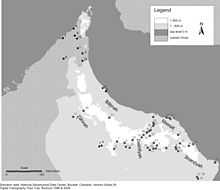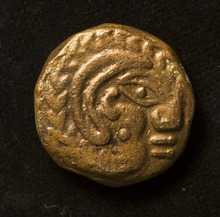Archaeology of Oman
The present-day Sultanate of Oman lies in the south-eastern Arabian Peninsula. There are different definitions for Oman: political, geographic.
While traditional Oman also includes the present-day United Arab Emirates, its prehistoric remains differ in some respects from the more specifically defined 'Oman proper' which corresponds roughly with the present-day central provinces of the Sultanate. The Oman Peninsula is more specific which juts into the Gulf of Hormuz. Archaeologically speaking, differences grow between the area of the present-day U.A.E. and the Sultanate particularly toward the end of the Early Iron Age. Archaeology is conditioned locally by the geographical situation. The amount of moisture dictates the amount and place of agriculture and population that are sustainable. A variety of subsistence strategies exploit the available resources. Since archaeological field work began in the Sultanate in the early 1970s, numerous teams have worked in the Sultanate.
Different ages are reflected in typological assemblages, Old Stone Age, New Stone Age, Copper Age, Bronze Age, Early Iron Age, Late Iron Age, that is Samad Period, so-called late pre-Islamic culture and the Age of Islam. What is referred to as a period is inferred from a regularly recurring assemblages of artefacts. Some specialists equate periods with cultures. The names of the ages are conventional and are difficult to fix in terms of absolute years. Aside from this the development is highly regional. The archaeological assemblages of the South Province Dhofar=Zafar differ completely from those of the central part of the country. A key barometer of industrial activity is the amount of copper production, as known from smelting refuse (slag) and metallic artefacts.
Except for the Islamic period, what all share is that they are known primarily from cemeteries, tombs and grave goods. The absolute dates for the different periods are still under study and it is difficult to assign years to the Late Iron Age of central and southern Oman. Even major monuments have been dated variously, spanning millennia. The meanings of major concepts such as Arab are controversial.
Old Stone Age: Known primarily from survey finds. Lithic findspots near Ra's al-Jins. Main sites include Saiwan-Ghunaim in the Barr al-Hikman.[1]
New Stone Age: The first agricultural settlements. Known from a variety of sites, most of which lie on the coast. The most characteristic feature is the domestication of plants and animals and a shift toward settled life.[2]


Copper Age, Hafit: Known originally from a cemetery site on the Jebel Hafit in the United Arab Emirates (UAE). Like the following Bronze Age periods, sites with characteristische finds are distributed over the UAE and Sultanate. Typically burial cairns lie on top of hill crests. Copies and pottery imports from southern Mesopotamia occur. Such finds have been documented on the eastern coast of the Sultanate near Ra's al-Hadd, especially HD-6 and Ra's al-Jins. Diagnostic pottery of Jemdet Nasr type has survived in some tombs. The smelting of oxidic copper ores begins, as perhaps at al-Batin.[3] Such ores would leave little slag and the process did not require special conditions. Already at this time there is textual evidence from Sumer for international trade in copper and other commodities, probably from Oman.
Bronze Age 2500 - 1900 BC: The Umm an-Nar and Wadi Suq Periods (1900 - 1300 BC). Known from numerous funerary sites, for example respectively on the island Umm an-Nar and in the Wadi Suq. Typical are nice wheel-turned painted vessels which distinguish these two periods. Metal production grows considerably in relation to that of the preceding Hafit Period. We know it mainly by means of planoconvex copper ingots which weigh 1–2 kg. Tower tombs, such as those at Shir, can only be approximately dated.[4] They may date to the Hafit or Umm an-Nar Periods. During the Umm an-Nar Period, large communal, free-standing tombs contain numerous interments. Other tombs are smaller and may contain one or a few interments. Settlement remains have been excavated at Ra's al-Jins (RJ-2).

Early Iron Age 1300 - 300 BC: Known from different cemetery and copper producing sites including the fort on the Jebel Radhania, Lizq. This period is known from some 142 archeological sites (or 161 depending on how one counts) located in the eastern part of the United Arab Emirates as well as the Central and northern part of the Sultanate of Oman. Usually hand-made, hard-fired pottery. The chronology and its nomenclature are controversial.[5] The pottery from the Lizq fort is most similar to that from the latest Early Iron Age sites at al-Moyassar and Samad al-Shan. In terms of pottery chronology, its beginnings there are obscure.[6] The dead are interred in existing subterranean tombs or in hut-like free-standing ones. Such tombs have poor chances of survival and as a ready source of building materials have rapidly disappeared since 1980. Copper production reaches a peak at this time which will only be surpassed in around the 9th century AD. The reason is that the technology to roast the more abundant sulphidic copper ore was developed. A hoard of copper alloy artefact at Ibri/Selme gives a fair idea of the production at this time.[7] The introduction of the falaj for irrigation coincides with the rapid growth of date as a main crop. The chronology for this age resembles but also differs from the better known one of the present-day U.A.E. During this Iron Age paradoxically in Oman iron artefacts have not yet been recovered. In neighbouring Iran after 1200 BC iron weapons are characteristic. Pre-Arabic place-names such as Izki, ṣuḥar and ʿIbri probably represent the bare remnants of the language and speakers of this and the next age.

Late Iron Age: Evidence exists for the Samad Late Iron Age from 150 BC to 300 AD, dated by means of a few outside comparisons. This assemblage is known from 74 archaeological sites in 29 localities and four suspected ones. Evidence for a transition from the EIA is rare in Central Oman and the situation is clearest at the multi-period site complex at al-Maysar (al-Moyassar): A [falaj] waters sites from the EIA, LIA and medieval periods. Over the centuries the water table dropped, so that the [falaj] floor had to be lowered to the height of the water table.[8] Samad LIA sites scatter over an estimated 80,000 km2. Defective radiocarbon dates found no acceptance. Samad al-Shan and smaller sites, such as al-Akhdar, al-Amqat and al-Bustan, are type-sites for this non-writing population, with mostly hand-made pottery, copper alloy and iron artefacts. Reoccurring pottery wares and shapes, small finds as well as a few grave structure types define the Samad Late Iron Age assemblage.[9] Typically, individual stone-built graves are sunk into the earth in the plain. Classical Samad graves have a small wall on the roof near one end perpendicular to the long axis. Few fragmentary settlement (Mahaliya, Samad S7) have been documented. No coins were struck locally, and to date only a single example has turned up in a context together with Samad Late Iron Age pottery. Some glazed pottery imports derive from the north. One class of pottery, balsamaria are wheel-turned and also are common in the late Pre-Islamic so-called PIR graves also in the U.A.E.. Approximately 3/4 of the Late Iron Age find inventories in Central Oman finds are attributable to the Samad assemblage, fewer to the so-called [préislamique récente], and a few cannot be attributed to a definable find assemblage. Certain towns in Oman perhaps were dominated politically and militarily by Parthian and later Sasanian invaders from Iran.[10] But for logistical reasons it was possible to occupy only a few sites. The bulk of the population were mixed Semitic speakers. Persian presence is inferred by a few place-names near or on the coast (e.g. Rustaq) and personal names in Izki. From ±500 BC to ±500 AD or later, waves of migratory tribes from South and Central Arabia settle in Oman and Iran as we know from different sources. The Azd tribes of course are far larger and more diverse than the area of the Samad Late Iron Age sites. These tribes brought the Old South Arabian and other languages with them as far east as Khorasan in Iran. They imported the first Arabic language to Oman. Perhaps the bulk of the Early Iron Age population of central Oman spoke so-called Modern South Arabian languages. There is a radical decline in population as compared to the preceding period. Evident is a loss of copper producing technology. The occurrence in Arabia and the Red Sea littoral of ribbed amphorae manufactured in Aqaba/Ayla evidently in order to transport wine, shows the area just north of Aqaba to habe been a fruitful agricultural area from 400 up to possibly 1000. On the other hand, D. Fleitmann has studied speliotherms from al-Hootha cave in central Oman and has gathered information for a series of megadroughts especially around 530. These may have afflicted the entire Peninsula. We need a greater resolution in dating dry and wet events in order to understand the climatic differences between Aqaba, Oman and the entire region in point of time.
Période préislamique récente:[11] Known from different sites in the Sultanate, for example Amlah, al-Fuwaidah. Such sites are largely contemporary with Late Iron Age of Samad in Central Oman, especially in Sharqiyah. In the U.A.E. such show evidence of writing such as on coins. A major difficulty in order to build chronology lies in the lack of clear artefactual parallels between the Samad assemblage and that of these sites. At the partially excavated cemetery site of al-Fuwaidah the artefacts, especially pottery and metalwork, are more similar to contemporary ones from the U.A.E. than to those of Samad.[12]
Late Iron Age in Dhofar: Survey and a few excavations shed light on the archaeology of the South Province of the Sultanate.[13] The largest and best-known site is Khor Rori - a trading fort established by the Hadhramite kingdom in the 3rd century BC.[14] While this site shows a mixture of artefacts, many of which are of Old South Arabian type, the surrounding countryside reveals a melange of different kinds of artefacts. Khor Rori owes its existence to the trading of aromatics, in particular frankincense. The type of sherd depicted was for many years considered to be Late Iron Age. Recent research re-dates to the medieval period.
Islamic Age: From the very beginning just after the arrival of Islam nothing has survived. The earliest building structures to survive date to medieval times. With the coming of Islam and the diaspora of Arabian tribes, the Arabic language takes hold in Oman. Copper production reaches a record high to judge from the amount of slag which has survived.[15] With 100.000 tons of slag, Lasail is the largest smelting site in Oman.
Sources
- Daniel T. Potts, The Persian Gulf in Antiquity, 2 vols., Oxford 1992
- Paul Yule, Cross-roads – Early and Late Iron Age South-eastern Arabia, Abhandlungen Deutsche Orient-Gesellschaft, vol. 30, Wiesbaden 2014, ISBN 978-3-447-10127-1
References
- ↑ Margarethe Uerpmann, Structuring the Late Stone Age of Southeastern Arabia, Arab. arch. epig. vol. 3, Issue 2, June 1992, 65–109; Serge Cleuziou & Maurizio Tosi, In the Shadow of the Ancestors (Muscat 2007) 19-31
- ↑ P. Biagi, The Shell Middens of the Arabian Sea and Gulf: Maritime Connections in the Seventh Millenium BC, in: A.R. Ansary et al. (eds.), The City in the Arab World, Riyadh 2005, 7-16; Serge Cleuziou & Maurizio Tosi, In the Shadow of the Ancestors (Muscat 2007) 63-88; Sophie Mery & Vincent Charpentier, Neolithic material cultures of Oman and the Gulf seashores from 5500–4500 BCE, Arab. arch. epig. 2013, 24, 73–78
- ↑ Paul Yule & Gerd Weisgerber, Die 14. Deutsche Archäologische Oman-Expedition 1995, MDOG 128, 1996, 135–155+Beilage 1, ISSN 0342-118x, URL: http://archiv.ub.uni-heidelberg.de/propylaeumdok/volltexte/2010/577/
- ↑ Paul Yule & Gerd Weisgerber, The Tower Tombs at Shir, Eastern Ḥajar, Sultanate of Oman, Beiträge zur allgemeinen und vergleichenden Archäologie (BAVA) 18, 1998, 183–241, ISBN 3-8053-2518-5,
- ↑ Jürgen Schreiber, Transformationsprozesse in Oasensiedlungen Omans. Die vorislamische Zeit am Beispiel von Izki, Nizwa und dem Jebel Akhdar. Dissertation, Munich, 1977. URL http://edoc.ub.uni-muenchen.de/7548/1/Schreiber_Juergen.pdf
- ↑ Stephan Kroll, The Early Iron Age Lizq Fort, Sultanate of Oman, translated and revised by P. Yule, Zeitschrift für die Kultur außereuropäischen Kulturen 5, 2013, 159–220, ISBN 978-3-89500-649-4
- ↑ Paul Yule & Gerd Weisgerber, The Metal Hoard from ‘Ibrī-Selme, Sultanate of Oman. Prähistorische Bronzefunde xx7, Stuttgart 2001, ISBN 3-515-07153-9.
- ↑ Gerd Weisgerber, The Impact of the Dynamics of Qanats and Aflaj on Oases in Oman, Internationales Frontinus-Symposium: Wasserversorgung aus Qanaten-Qanate als Vorbilder im Tunnelbau, 2.-5. Oktober 2003, Luxemburg, Heft 26, 2003, 61–97, esp. 74–7 fig. 24–9
- ↑ Paul Yule, Die Gräberfelder in Samad al-Shan (Sultanat Oman) Materialien zu einer Kulturgeschichte. Orient-Archäologie 4, Rahden 2001, ISBN 3-89646-634-8 ; Paul Yule, Cross-roads – Early and Late Iron Age South-eastern Arabia, Abhandlungen Deutsche Orient-Gesellschaft, vol. 30, Wiesbaden 2014, ISBN 978-3-447-10127-1, pages 62-66
- ↑ Paul Yule, Late Pre-Islamic Oman: The Inner Evidence – The Outside View, Hoffmann-Ruf–M. al-Salami, A. (eds.), Studies on Ibadism and Oman, Oman and Overseas, vol. 2, Hildesheim, 2013, 13–33, ISBN 978-3-487-14798-7
- ↑ Michel Mouton, Mouton, M. 1992/2008 La péninsule d’Oman de la fin de l’âge du fer au début de la période sasanide (250 av. – 350 ap. JC), BAR International Series 1776, (printed 2008)
- ↑ Paul Yule, ʿAmlah, al-Zahirah (Sultanat Oman) – späteisenzeitliche Gräberfelder 1997, in: Paul Yule (ed.), Studies in the Archaeology of the Sultanate of Oman 1999, Orient-Archäologie 2, 119–186
- ↑ Juris Zarins, The Land of Incense. Archaeological Work in the Governorate of Dhofar, Sultanate of Oman 1990-1995, Muscat 2001.
- ↑ A. Avanzini, A Port in Arabia between Rome and the Indian Ocean (3rd century BC – 5th century AD), Rome 2008
- ↑ Gerd Weisgerber, Die Suche nach dem altsumerischen Kupferland Makan, Das Altertum 37, 1991, 76-90
External links
| ||||||||||||||